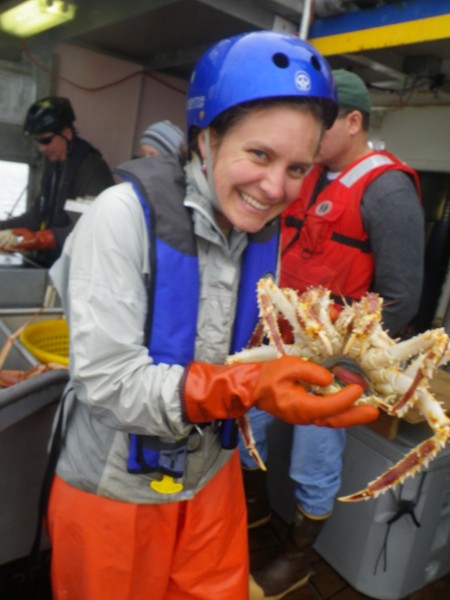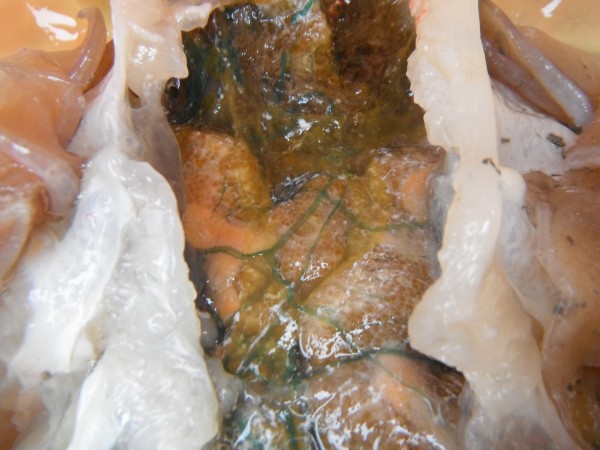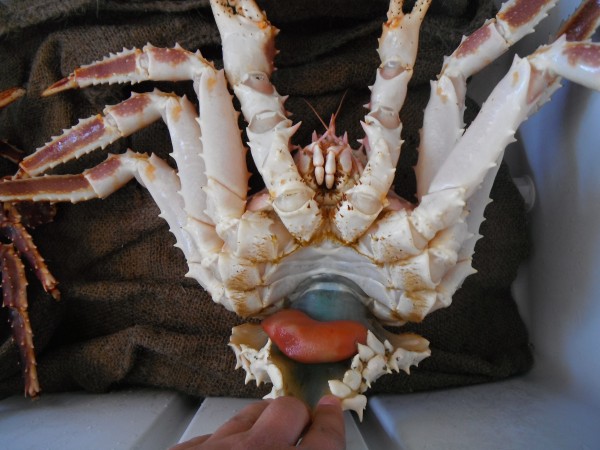Zombie-generating crab parasites pose intriguing mysteries
March 11, 2016
Lauren Frisch
907-474-5022
Nobody knows how the parasitic barnacles create zombie crabs.
King crabs, already otherworldly creatures, grow even stranger when barnacles invade
them. The insides of infected crabs become filled with green, branching tendrils that
resemble plant roots.

Barnacles are marine animals with outer shells, related to crabs and lobsters. Typically, they live on rocks or the sides of boats, filtering food from the water. However, Briarosaccus barnacles infect king crabs, turning them into “zombies” that raise and nurture the parasite’s eggs.
“The parasite basically takes over the crab’s brain,” said Sarah Hardy, an associate professor at the University of Alaska Fairbanks School of Fisheries and Ocean Sciences. “The crab is a walking incubator for the parasite’s larvae. But we know basically nothing about how the control takes place.”
Scientists do not have a strong understanding of how many crabs are infected, or under what conditions the parasite thrives.
Leah Sloan, a Ph.D. student at SFOS, is working with Hardy to study both the mechanism for control and the range of temperatures and salinities the barnacle can tolerate. Sloan also wants to develop easier ways to detect infected crabs.
“I was excited to take on this research because of its potential importance to the valuable king crab fisheries of Alaska, but also wanted to study this species simply because of the thrill of discovering the secrets of a species that hardly anyone has ever studied before,” Sloan said.
Briarosaccus barnacles infect Alaska’s three commercially harvested king crabs. In 2014, the total ex-vessel value for blue, red and golden king crab fisheries was approximately $96 million.
The parasites won’t turn us into zombies, Sloan assures. If we were to eat one by accident, we would digest it normally.
Although parasitic barnacle populations are currently low in Alaska, understanding how environmental changes impact the ability of the parasite to thrive could help fishermen prepare for future peaks in populations.

In the lab, Sloan raised parasite larvae at different temperatures and salinities to monitor survival frequency and length of development. Her project is part of the National Science Foundation–funded Marine Ecosystem Sustainability in the Arctic and Subarctic program. She received additional funding from a North Pacific Research Board student grant, a Rasmuson Foundation fellowship, the Northern Gulf of Alaska Applied Research Award, and the SFOS Robert and Kathleen Byrd award.
Sloan found that warmer temperatures could significantly speed up development time for larvae.
“In general, face a lot of dangers in the larval stages that might have a larger effect when development takes longer,” she said. When development time is shorter, it could be easier for larvae to survive.
Unless a parasite’s egg sac is present, biologists cannot determine visually whether crabs are infected. Sloan is studying small molecules in infected and uninfected crabs, and hopes to develop biomarkers that would allow scientists to identify infected crabs with a blood test.
Sloan’s work will help researchers begin to gauge how parasite numbers may change as ocean temperatures increases. If Sloan develops a method that makes it easier to identify infected crabs, this could help the researchers determine how many infected crabs are in Alaska waters and work on strategies to mitigate the impact of the parasite on commercial crab populations.

ADDITIONAL CONTACTS: Leah Sloan, lmsloan@alaska.edu, 907-474-5939; Sarah Hardy, smhardy@alaska.edu, 907-474-7616
ON THE WEB: Read more here.


